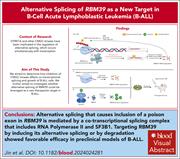Issue Archive
Table of Contents
BLOOD COMMENTARIES
Reengaging life post-BCMA for myeloma
Clinical Trials & Observations
Moving forward in good KarMMa in myeloma
Clinical Trials & Observations
CLINICAL TRIALS AND OBSERVATIONS
Efficacy and safety of teclistamab in patients with relapsed/refractory multiple myeloma after BCMA-targeting therapies
Clinical Trials & Observations
Two articles in this issue highlight the impact of B-cell maturation antigen (BCMA)–targeted therapies on relapsed/refractory multiple myeloma (R/RMM). Touzeau and colleagues report a phase 1/2 trial of teclistamab, a BCMA-directed bispecific antibody for patients with R/RMM with prior exposure to other BCMA-targeted therapy and a median of 6 prior lines of treatment. Overall response rate was over 50% with a median progression-free survival (PFS) of 4.5 months, with tolerable side effects. This supports teclistamab as an effective and safe therapy for R/RMM even with prior anti-BCMA treatment. In the second article, Ailawadhi et al present the final results of the phase 3 trial comparing idecabtagene vicleucel (ide-cel) to standard regimens (SRs) for triple class–exposed (TCE) R/RMM. With a median follow-up of 30.9 months, ide-cel improved median PFS over SRs (13.8 vs 4.4 months, respectively). Early failure was attributable to progression while awaiting therapy, and overall survival analysis was confounded by crossover of SR to ide-cel upon disease progression, demonstrating the favorable benefit-risk profile of ide-cel in TCE R/RMM.
Ide-cel vs standard regimens in triple-class–exposed relapsed and refractory multiple myeloma: updated KarMMa-3 analyses
Clinical Trials & Observations
Two articles in this issue highlight the impact of B-cell maturation antigen (BCMA)–targeted therapies on relapsed/refractory multiple myeloma (R/RMM). Touzeau and colleagues report a phase 1/2 trial of teclistamab, a BCMA-directed bispecific antibody for patients with R/RMM with prior exposure to other BCMA-targeted therapy and a median of 6 prior lines of treatment. Overall response rate was over 50% with a median progression-free survival (PFS) of 4.5 months, with tolerable side effects. This supports teclistamab as an effective and safe therapy for R/RMM even with prior anti-BCMA treatment. In the second article, Ailawadhi et al present the final results of the phase 3 trial comparing idecabtagene vicleucel (ide-cel) to standard regimens (SRs) for triple class–exposed (TCE) R/RMM. With a median follow-up of 30.9 months, ide-cel improved median PFS over SRs (13.8 vs 4.4 months, respectively). Early failure was attributable to progression while awaiting therapy, and overall survival analysis was confounded by crossover of SR to ide-cel upon disease progression, demonstrating the favorable benefit-risk profile of ide-cel in TCE R/RMM.
HEMATOPOIESIS AND STEM CELLS
Clonal landscape and clinical outcomes of telomere biology disorders: somatic rescue and cancer mutations
Telomere biology disorders (TBDs) are caused by pathogenic germ line mutations in telomere-related disease and are associated with multiorgan disease and a cancer predisposition. Clonal hematopoiesis (CH) is an age-related phenomenon that may also increase the risk of myeloid malignancy. Gutierrez-Rodrigues et al investigated the correlation of CH with malignancy development in TBDs. Rates of clonal hematopoiesis in patients with TBDs were higher than in age-matched control patients, and evidence suggests that telomere dysfunction causes selective pressure for expanded CH, which is a poor prognostic marker suggestive of worse survival. Mutations in TP53, TERT promoter, and splicing factor genes were especially deleterious.
LYMPHOID NEOPLASIA
Disruption of cotranscriptional splicing suggests RBM39 is a therapeutic target in acute lymphoblastic leukemia
While splicing factor mutations are frequent findings in myeloid malignancy, they are not seen in acute lymphoblastic leukemia (ALL); however, there is evidence that dysregulation of splicing is common in ALL cells. Jin and colleagues investigated splicing in ALL and report that downregulation of RBM39, a component of the splicing machinery, suppresses human B-cell ALL growth in vitro and in vivo. RBM39 may be a novel therapeutic target in relapsed/refractory ALL.
Measurable residual disease by mass spectrometry and next-generation flow to assess treatment response in myeloma
Clinical Trials & Observations
Brief Report
Quantitative immunoprecipitation mass spectrometry (QIP-MS) allows detection of measurable residual disease (MRD) through detection of M-protein in peripheral blood in patients with multiple myeloma (MM). Puig and colleagues compared the sensitivity of serum QIP-MS to next-generation flow cytometry in bone marrow to measure MRD in paired samples before and after induction, transplant, consolidation, and maintenance therapy of patients with MM in 2 clinical trials. There is excellent correlation between the 2 modalities, suggesting that minimal invasive monitoring could replace bone marrow assessment of MRD.
MYELOID NEOPLASIA
Recurrent CLTC::SYK fusions and CSF1R mutations in juvenile xanthogranuloma of soft tissue
Clinical Trials & Observations
Juvenile xanthogranuloma (JXG), adult xanthogranuloma (AXG), and Erdheim-Chester disease (ECD) are histiocytic neoplasms that usually present in the skin, but in rare cases, patients have extracutaneous lesions. While ECD is frequently associated with BRAF mutations, AXG and JXG are not. Kemps et al investigated the clinicopathologic and molecular data on 16 children and 5 adults with XG, reporting that 16 out of 16 children, but only 1 adult, displayed targetable kinase alterations, including frequent CLTC::SYK fusions and mutations in CSF1R. Although most lesions are treated with local resection, some regress spontaneously and rarely need further treatment; these targetable mutations may guide therapy for recurrent or persistent disease.
LETTER TO BLOOD
-
Cover Image
Cover Image
![issue cover]()
Photomicrograph of a hematoxylin and eosin–stained slide of a histiocytic tumor harboring a
CLTC ::SYK fusion, which was resected from the lateral upper leg of a 1-year-old child. The tumor consisted of a dense population of cells with xanthomatized eosinophilic cytoplasm, as well as multiple collections of foamy histiocytes. See the article by Kemps et al on page 2439. - PDF Icon Front MatterFront Matter
- PDF Icon Table of ContentsTable of Contents
- PDF Icon Editorial BoardEditorial Board
Advertisement intended for health care professionals
Email alerts
Advertisement intended for health care professionals








